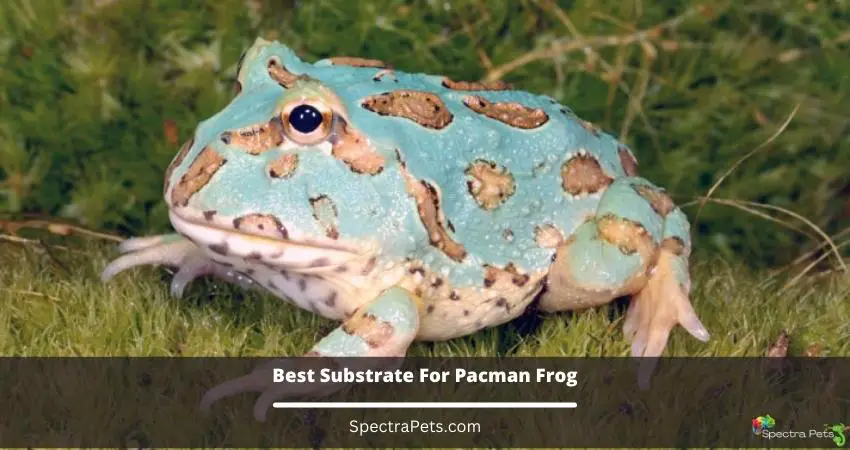The Samurai Blue Pacman is a beautiful Pacman species that belongs to Ceratophrys Cranwelli. It’s one of the most popular choices for pet frogs, and it’s not hard to see why.
The captivating blue skin color will attract anyone’s mind let alone a frog lover. In their baby time, they have a greenish look but in their adulthood, they look bright blue.
They’re unique-looking creatures that are generally easy to care for. However, there are still some things you need to know in order to give your Samurai Blue Pacman the best possible care.
In this blog post, we’ll cover everything from tank size and substrate to diet and cleaning the tank. By the end, you’ll be an expert on Samurai Blue Pacman care!

How to take care of Samurai Blue Pacman
Taking care of your exotic Pacman frog won’t be a hard job. Proper monitoring will help the frog reach its adult stage with a good body shape within a year.
Stay tuned to see how you can take of these magnificent creatures.
Tank Size
When choosing a tank for your Pacman frog, size matters. A small frog can easily be lost in a large tank, and a large frog may feel cramped in a small one. Ideally, your frog’s tank should be at least 10 gallons.
This will give your frog enough room to move around and explore while providing plenty of hiding places. Remember, Pacman frogs are timid creatures and prefer to spend most of their time hidden away. So, don’t forget to include plenty of plants and hideaways in your frog’s tank.
Substrate
The best substrate for a Samurai Blue Pacman is coco fiber or moss. You can also use soil, but it’s important that it’s pesticide-free.
However, you need to keep in mind that moss, coco fiber, and leaf litter are suitable for baby and juvenile Samurai Blue Pacman frogs. In this way, they will find burrowing easier.

Adults will feel more comfortable on a soil-type substrate with more depth because they have more strength so hiding won’t be a big deal.
Lighting Setup
Your lighting setup will depend on whether or not you’re growing live plants in your Frog’s enclosure. If you are, you’ll need a full-spectrum light bulb that emits UVB rays. If you’re not growing live plants, you won’t need a special light bulb.
Adding a top-notch low UVB bulb would be beneficial for the Pacman frog. A little bit of light would help your frog to regulate vitamin D3 properly.
Proper Diet and Supplement
A good diet for a Samurai Blue Pacman consists of crickets, earthworms, wax worms, and mealworms. You should dust all insects with calcium powder, and multiple vitamins before feeding them to your Frog. You can supplement your Frog’s diet with freeze-dried shrimp or bloodworms.
Baby horned frogs need to eat meals every single day. The size has to be the smallest insects available on the market. For sub-adult or adult Samurai Blue Pacman, you have to provide 3-4 large-size meals per week.
Most of the experienced Pacman owners suggest keeping the cricket or dubia roaches as the staple food. Because it has got ample amount of nutrients for your frog.
Cleaning the Tank
One important part of Samurai Blue Pacman frog care is cleaning the terrarium. A Samurai Blue Pacman’s terrarium should be spot-cleaned every day and completely cleaned and disinfected every two weeks. You should clean your Frog’s tank with distilled water or water that has been treated with a dechlorinator.
Spot-cleaning involves removing any visible waste, uneaten food, or other debris from the terrarium. The entire terrarium should then be cleaned with a mild soap and water solution, being sure to rinse everything thoroughly.
All décor, substrate, and hiding places should be removed and disinfected before being put back in the terrarium. While it may seem like a lot of work, cleaning the terrarium is essential to keeping your Samurai Blue Pacman frog healthy and happy.
Temperature & Humidity
The ideal temperature range for a Samurai Blue Pacaman is 75-85 degrees Fahrenheit during the day and 60-70 degrees Fahrenheit at night. The humidity level should be kept between 60-80%.
An extremely low or high temperature will lead to the digestion problem of your Samurai Pacman. Even too long a time staying under abnormal temperature can become fatal for this little creature.
Worst is the bacteria and parasites just need the imbalance of temperature and the frog can be easily attacked by these. Loss of appetite & hibernation can occur due to the wrong temperature & humidity.
Always check the humidity and temperature with high-quality tools like a hygrometer and digital temperature gauge.
Prevent Disease of the frog
One of the best ways to prevent disease in your Samurai Blue Pacman Frog is to quarantine new frogs before adding them to your collection during the breeding time.
This will help stop the spread of disease if any of your new animals are sick. You should also disinfect anything that comes into contact with your Frogs, including their food and water bowls and any decorations in their enclosure.
Also, make sure to wash your hands before and after handling your Frogs as this will help prevent the spread of disease from you to them or vice versa.
Plants for tank
However, selecting plants that are not toxic to frogs is important, as some species can be poisonous. Dracaena compacta and Syngonium are both safe choices for a Pacman frog terrarium.
Episcia cupreata is also a safe choice, but it is important to note that this plant can be toxic to other animals, so it should not be kept with other pets. When selecting plants for a Pacman frog terrarium, it is important to choose species that will thrive in the humid environment of the terrarium.
All the plants listed above are good choices for a Samurai Blue Pacman frog terrarium and will provide your pet with a safe and healthy environment. In addition, these plants are all known for their ability to filter toxins from the air, making them ideal for creating a healthy environment for your frog.
Read More: Can Pacman Frogs Live Together?
Signs of Sickness in Samurai Blue Pacman
There are several signs that may indicate that your frog is sick including lethargy, loss of appetite, inability to right themselves when flipped over, discoloration, mouth sores, bruising, bulging eyes, excessive shedding of skin, respiratory distress, and spasms.
Anytime you see these signs in your frog, it’s important to take them to see a reptile/amphibian veterinarian as soon as possible as they could be suffering from a serious illness that needs treatment and I know no one wants their frog to be sick!
Water type for misting
There are a few different types of water you can use for your Samurai Blue Pacman frog’s tank misting and plant growth. While distilled or reverse osmosis water is the best option, you can also use tap water that has been treated with a dechlorinator.
Spring water is also an option, though it may contain minerals that can build up over time and affect water quality. Whichever type of water you choose, be sure to monitor the quality of care and make changes as needed to ensure your frog is doing good.
Related Article: Strawberry Pacman Frog Care
Conclusion
As long as you provide them with the proper care, your Samurai blue Pacman will thrive!
By following these simple guidelines, you can ensure a happy and healthy life for your little friend! Hopefully, this article helped you to get the whole idea about how to take care of Samurai Blue Pacman.
